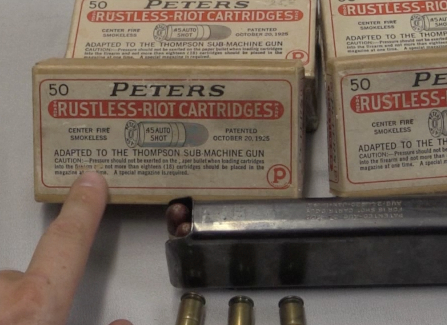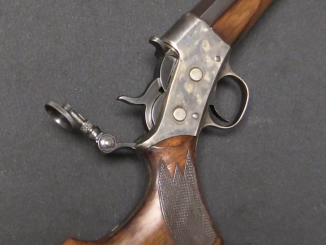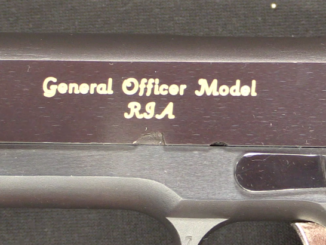Sylvester Roper is not a well known name in firearms history today, but he made a number of notable contributions to the field – in addition to his work with motorcycles and automobiles where he is much better remembered.
The Roper revolving shotgun was an early cartridge-firing repeating shotgun that could carry and fire four rounds without reloading. It was offered in both 12ga and 16ga (this one is 12ga) and used a rather unusual open-bolt mechanism. Cocking the hammer fully would bring a shell into position between the bolt and chamber, and firing the gun would cause the bolt to drop forward, chamber the cartridge, lock in place, and immediately fire. Re-cocking the hammer would extract the fired case but leave it in the rotary magazine, and then bring a new shell into position to be fired. As a result, one could fire four rounds and then would have to unload the 4 empty shells form the magazine carousel before reloading.
Roper would go on to share the patents for the first pump action shotgun with Christopher Spencer (better known for his lever action rifle used in the Civil War) before his ultimate death on a steam-powered velocipede (we all have to die eventually, and that was a cool way to go!).




Interesting how gun and motorcycle development overlapped… there weren’t many made but everything I’ve read about Iver Johnson motorcycles (seems like there were both singles and a V-twin) indicates that they were actually much better designed and manufactured than the Indians and Harleys of the pre-WW1 era. Steam-powered velocipede… probably my favorite scene from the “Wild, Wild West” movie.
It’s not all that surprising when you consider things like Arthur William Savage, the founder of Savage Arms, was the inventor of the radial tire.
“Steam-powered velocipede…”
You can see THE ROPER STEAM BICYCLES (and not only) photos there:
http://douglas-self.com/MUSEUM/TRANSPORT/steambike/steambike.htm
Also this link stated that: “Roper died of a heart-attack on 1 June 1896, while driving this machine at 40 mph on a local bicycle track in Boston.”
Well– fascinating.
I’m not a shotgun guy but I do like history.
I had no idea that there was such a gun.
I sure learn a lot from you Professor Ian!
Regards
Pat
Firearms, motorcycles, airplanes, submarines are all part of a true mechanical genius’s repertoire. If one can design and fabricate a new firearm, then the same engineering and fabrication skills can develop and fabricate engines and their respective vehicles. Hiram Maxim attempted aircraft design with steam power! Glenn Curtis went from motorcycle engines and racing to aircraft design and fabrication. But of course he and Bell told outright lies in attempts to rob the Wrights of their patent on three axis control. Just imagine a J.M. Browning motorcycle or airplane!!!
“Hiram Maxim attempted aircraft design with steam power!”
Now Maxim is mostly remembered for his machine gun, but he also invents many, many other devices. Just see his patents:
https://www.google.com/search?tbo=p&tbm=pts&hl=en&q=ininventor:%22Hiram+S.+Maxim%22
“If one can design and fabricate a new firearm, then the same engineering and fabrication skills can develop and fabricate engines and their respective vehicles”
See for example Nagant brothers.
It was not uncommon “way back when” for anyone mechanically inclined to have several areas of expertise such as Roper’s interests in fire arms and motorcycles. Probably this was inherent of the blacksmiths who were the previous “mechanics.” I can remember my grandfather hammer-welding a Model T Ford broken rear axel and re-installing it into the vehicle when I was a kid. This continued into the post-WWII era as is shown by Howard Hughes’ interests in both VERY fast airplanes and innovative automobiles such as his designing and building an advanced steam powered automobile. Eli Whitney developed the cotton gin and made parts and finished weapons during the Civil War leading to the development of interchangeable or standardized parts. Most previous gunmakers did one-off versions prior to his developments. If a part broke you either had a blacksmith make a replacement or adapted another part from some other gun by “fitting” it to your gun. An example of this is the .46 caliber Girandoni air rifle now owned by Dr. Beeman that was the same one carried by the Corps of Discovery Expedition (1804-06), led by Meriwether Lewis and William Clark. During the expedition the main spring broke and was repaired by the expedition’s blacksmith making a replacement from a file. The weapon still has this replacement spring in it and the “teeth” of the file or rasp are still plainly shown even in a “ground-down” state.
Eli Whitney was not the first to come up with interchangeable parts. He just popularized the idea. The 1819 Hall rifle was probably the first production gun made with fully interchangeable parts.
Neither Marconi nor Tesla actually “invented” radio, and Marconi had to use a Tesla Coil in his first long-distant demonstration; there were several who had to some degree developed the science prior to him including a farmer in, if memory serves, Kansas, whose first device was reportedly mounted on two wagons, each with a transmitter/receiver so they could “talk” to each other, that transmitted voice instead of Morse code. The power was derived from liquid batteries. These were demonstrated to and written up in the New York Times who ridiculed him as a charlatan. He was contacted by the “Scientific American Magazine” but by the time they arrived he had burned his barn/laboratory and home and disappeared into the west leaving the field open to later developers. Neither did Henry Ford invent the automobile, probably first built by Karl Benz, nor did the Wright Brothers build the first “aeroplane” that flew, probably beat by Gustave Whitehead instead, but the above did bring these advancements into accepted practice so they get all the notoriety and fame. History is replete with such stories of fact so don’t even think about getting me started on the work of John Searl’s “Searl Effect Generator” that the Russians, Sergei Godin & Vladimir Roshchin witnessed tests, that appear to have proven at least partially effective in several test runs. So IF this technology is ever developed, which one of the people involved will get the credit for it? I would postulate that it will be the one who makes enough money to get the attention of the contemporary press just like those above. The rest will get nothing but a terse footnote in history.
The patent for the aeroplane, flying machine, had been given earlier, but it did not work. The key was three axis control which the Wright brothers patented. Nobody prior to this time had perfected the concept of three axis control.
LG;
Both Samuel Langley and Wilhelm Kress had developed multi-axis control about the same time the Wright Brothers did. Their system, relying on separate pivoted control surfaces on the wings (ailerons) became standard because it was sturdier with conventional materials than the Wrights’ wing-warping system. Incidentally, “wing-warping” was a forerunner of the Mission Adaptive Wing technology of today; we just have better materials to make it with. (The Wrights tended to be ahead of their time as a matter of habit.)
Kress attempted a flight with his prototype on Lake Tullnerbach in Austria in October 1901, two years before the Wrights’ first powered flight. Unfortunately for him, the Daimler engine he had, which was supposed to deliver 40 HP and weigh 500 pounds, ended up nearly twice as heavy with no greater output. As such, before he could get off the weather, he hit floating debris and flipped. By the time he got his prototype rebuilt and fitted with an engine that fit his original specs, the Wrights had beaten him into the air.
(Connections by James Burke. Chapter 6, “Fuel to the Flame”, pp. 182-83.)
cheers
eon
Even the courts eventually sided with the Wrights for three axis control. The Wrights proved conclusively that their patent covered BOTH wing warp and aileron type systems. The reason that the original Wright Flyer was housed in the British Museum instead of the US was because of Langley’s unfounded claims. Yes Langley was able to hurl trash into the Potomac River, but NEVER able to control flight. Three axis control is needed, not just a rudder as a boat. The Wright’s association with bicycles gave them insights into three axis control that the politically connected Langley never had. Kress was thinking that an airplane was a ship of the sky, he had not thought out or completely tested three axis control as had the Wrights. Also the wind tunnel tests of the Wrights proved that the published lift coefficients were incorrect. This, among other things, allowed them to develop the most efficient propellor of its day. A propellor is a rotating air foil, not an screw of a propellor ship. Without the efficiency of the Wright propellors, the Wright Flyer could not have sustained flight with its Wright designed and fabricated engine.
In late 19th century / early 20th century humans believed in that technology will sooner or later allow things then not possible – see Jules Gabriel Verne works, for example De la terre à la lune https://en.wikipedia.org/wiki/From_the_Earth_to_the_Moon
As a former participant in the early space program (Atlas ICBM program at Cape Canaveral/Hangar J in 1957) this one hits yet another nerve. My grandparents remembered when people said to ignore the Wright Brothers when they “thought” they were flying the plane that was whizzing through the air alongside the train they were on. Then they were told that no man could live through traveling 60 miles per hour … then 100 hundred miles per hour. Next was the speed of sound that Chuck Yeager shattered. They told us the Atlas would collapse upon itself when we told the press it would fly at 3,000 mpg outside the atmosphere. Nest came surviving Escape Velocity of the earth; landing on the Moon; putting a probe on Mars, etc. In recent days we saw a space probe take pictures of Pluto after a 9.5 year journey at more than 30,000 miles per hour. Speed of light? They already did that and if the instruments are to be believed they exceeded this “barrier” by a fractional factor as well. So what are the limits? I hate to admit that I will not be alive to see, but it is going to be “faster then a Chevy V-8” as Brother Dave Garner used to phrase it.
As a graduate of Case Western Reserve University, which worked with NASA and pretty much helped to develop the rockets in Cleveland (ha, most people probably thought the rockets came from Pittsburg or some other famous city), I must say that social expectations are often shattered first by authors and then by real life works.
As a side note to Daweo’s mention of Maxim’s patents, one of the first was the proverbial “better mouse-trap.” You wound the thing up before you went to bed, and by morning you’d have not one, but perhaps six dead mice in the bin, as the trap would use the tension force from the main spring to reset itself after killing a mouse, thereby readying itself for another victim.
Humm, shall we start a list of firearm manufacturers / developers that also dabbled in Motercycles?
Iver Johnson
Roper
FN
You forgot BSA and Enfield sort of since they had a contract with a company that then called themselves Enfield afterwards then went on to make motorcycles.
Birmingham Small Arms made all sorts of products in their long history, we can also look at all the companies in the U.S.A. who went from making sewing machines, juke boxes, typewriters, etc. to manufacture firearms when needed.
Singer (Sewing Machines) did make a batch of 1911 pistols just before WWII, but were not especially efficient at it and the tooling was sent elsewhere. But IBM (the computer company), Rock-ola (juke boxes), National Postal Meter, Saginaw Steering (car parts), Guide-Lamp (car parts), Smith-Corona (typewriters), Underwood (typewriters), and International-Harvester (agricultural equipment) all made guns in WWII. Probably others. In other times Westinghouse and TRW (industrial conglomerates) made rifles.
And the punch line is that IBM, International Business Machines, was originally Tabulating Machines Inc, a firm started by Herman Hollerith, an engineer formerly employed by the U.S. Census Bureau who developed an early form of electrical punch-card reader to speed up the tabulating process in the 1880 census. (Punch cards had been used for a century, mainly to run things like the Jacquard/Vaucanson looms. Hollerith was the first to use electrical contacts to register data from the cards on analogue instruments.)
It became Business Machines Inc. in 1904 when it began making adding machines and other apparatus in addition to the tabulators.
Hollerith’s partner in the firm was none other than Christopher Spencer, of “repeating rifle” fame.
cheers
eon
Benelli (motorcycles) and Benelli (shotguns) are no longer the same company, but they used to be.
theodor bergmann.
bicycles and cars.
There is a lot of crossover between guns, bicycles, motorcycles and cars in the early days. FN made motorcycles including an early 4 cylinder model, plus cars and military trucks. Steyr ties into motorcycles via Puch,which were sold in the US as a Allstate. CZ also made guns and motorcycles, and Valmet made Porsche Boxsters and Saab 900s. BH in Spain definitely makes bicycles, and may have made mopeds.
Roper’s set up seems to imply that he didn’t want hunters losing their cartridge brass (kind of hard to come by back then) while chasing deer…
Also,
Husqvarna
CZ
Simson
Oddly enough, despite their slogan ‘Made Like a Gun’ Royal Enfield never had anything to do with the manufacture of firearms. I checked this with my boss many years ago whose previous employment, prior to their closure, was as chief designer for Royal Enfield Motorcycles.
Wasn’t Roper the inventor of removable shotgun choke tubes?
Ian, that case without a primer/percussion cap has a single hole which would make it Boxer, not Berdan primed.
And Isidore Loewe, who started making Singer-type Sewing Machines, then went into Machine tool Production, then Gun Barrels for the Prussian state, and as Ludwig Loewe became a Rifle (G88) and Handgun Maker ( S&W no3 Russian) (Prussia and Tsarist Russia) and eventually Became “DWM” (Owning Mauser, FN, Loewe Machine Tools, etc, and a stake in FA Oviedo, and OEWG Steyr.
as to the Roper Shot5gun, I now recall seeing one at the Toowoomba Gun sho this last weekend (Qld. Australia); I didn’t recognise it, but now I know what it was…didn’t see the Price, though, it was amongst a lot of other Mid 1800s rifles and Muskets.
Just goes to show in the Current controversy about “Repeating” Shotguns (Lever Action, Adler from Turkey) here in Australia, that repeating shotgun Technology is as old as 1855 (Colt revolving Shotgun) and the 1887 Browning Winchester…but our Burocrats seem to be Hornswoggled by the Advertising for the Adler and consider it a dangerous, terrorist weapon…and Banned its import, and are considering banning (and confiscation)of ALL lever action guns (Rifles, shotguns,) in Australia….some chance… especially with Federal election next year, and well over 500,000 shooters (licensed) in Australia…
Doc AV
Is there any known connection between Roper and the Blake rifle. The revolving magazine makes me wonder.
I have seen several Ballard cartridge rifles which had been converted in period to use a drilled out spent cartridge and a percussion cap.
And Rolls Royce dabbled with a .55 calibre machinegun which they dropped as they were way to busy making aero-engines.
It used the 0.55in Boys AT rifle round, which would have made it one of the most formidable aircraft MGs in the world at the time. But the RAF was committed to the 20mm Hispano cannon and the Browning 0.303in rifle-caliber MGs as fighter armament, so there really wasn’t much official interest in it.
Even when the 0.50in Browning became “official” fighter armament with the Spitfire Vb and IXb (one 20mm Hispano, one 0.50in Browning, and two 0.303in Brownings in each wing), the RAF squadrons tended to unship the 0.50s and use their space for additional ammo space for the Hispanos. Followed by the later Griffon-engined Spits with the “Universal” wing, with four 20mm Hispanos, period.
The Hurricane IIb had as many as 12 0.303in Brownings, six per side. The Spitfire Ib had eight 0.303s total. They certainly could turn an He-111 into scarp with these, but they had to get within range of the bomber’s own rifle-caliber (7.9mm) MGs to do it. And there were of course all those cannon-armed Bf-109s about.
It occurs to me that fitting the “Spit” and “Hurri” with six or eight 0.55in Rolls-Royce MGs each would have made a bit more sense in context.
cheers
eon
I am delighted that Ian got another chance to see one which still had it’s bits. What a fascinating design. It seems like it was a fairly practical gun for the time.
I was recently reminded of the Roper thanks to a GURPS supplement of all things.
They indicated in the game stats that it used a 12ga 2-5/8″ shell, and that got me thinking that perhaps the difference in the extractors you noticed had something to do with what kind of round.
Could the bottom extractor design be for the steel pre-loaded Roper cartridges and the top extractor be for more conventional rounds?
What few mentions of the gun I’ve found online don’t mention the steel cartridges, which makes me wonder.
Hello
I,am looking for a drawing and dimensions off a 12 ga Roper shotgun shell